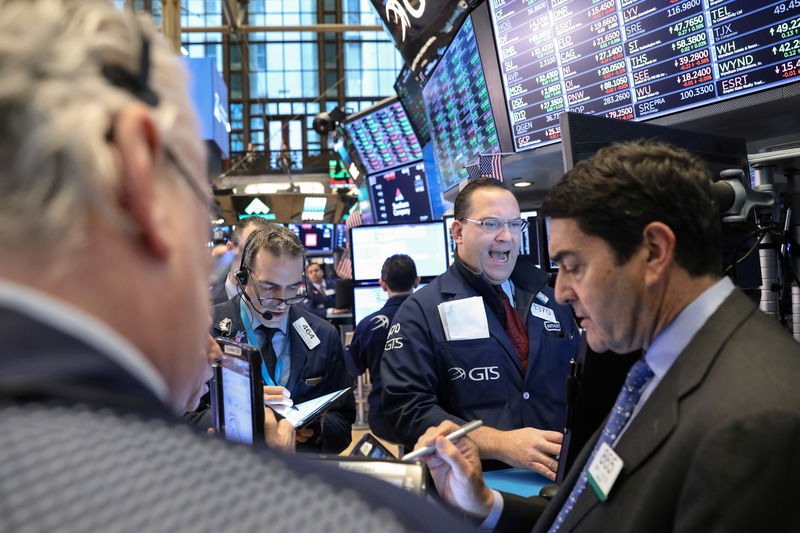By Kate Duguid
NEW YORK (Reuters) - While stocks hog the limelight with their best January in three decades, another corner of the risk assets marketplace sprang back to life last month after having taken a pounding at the end of last year, though some investors question whether the recovery has legs.
Junk bonds in January delivered their strongest monthly performance in more than seven years with a total return of nearly 4.6 percent, according to ICE (NYSE:ICE) BofAML index data, retracing almost all of the fourth quarter's losses. Issuance of new debt rebounded after a near-complete shutdown in December.
(For a graphic on 'Junk bonds roared back to life in January' click https://tmsnrt.rs/2t2csEy)
Along with the surge in stocks, it would appear to be an endorsement of a U.S. economy that continues to outperform its global peers, as well as the shift by the Federal Reserve to a wait-and-see posture regarding future interest rate increases.
Companies with risky credit profiles brought $11.7 billion in new high-yield debt to the market in the first month of the year, after a nearly six-week dry spell at the end of 2018. The bounce-back from December has led fund investors to put the most cash into high-yield bonds since 2016, according to Lipper.
That backdrop would typically be seen as constructive for more gains. Some big bond managers, however, remain skeptical of the rebound, attributing it more to a clutch of technical factors that will soon peter out than to a lasting improvement in fundamentals.
"We don't think this is a particularly strong buying opportunity," said John McClain, portfolio manager at Diamond Hill Capital, anticipating a market correction that will pull prices lower. Strong high-yield gains in January 2018 were more than erased by a volatile February.
December saw just $594 million in high-yield deals, the lowest monthly issuance since August 2008. Companies stepped back from raising debt because global macroeconomic trends - such as slowing global growth, the U.S.-China trade war and Brexit - had whipped up volatility in financial markets. But when Fed Chairman Jerome Powell last month signaled a pause in the U.S. central bank's interest-rate hiking policy, confirmed in last week's policy statement, markets rebounded.
Still, the high-yield market's recovery from the December trough adds up to less than half of January 2018's issuance. The relatively small size of the market may be artificially buoying prices. The compensation paid to high-yield bond investors for holding riskier securities, which had widened to 5.357 percent over Treasuries on Jan. 3, has narrowed by 108 basis points since, according to ICE BofAML indexes.
"The (junk bond) market is currently weak. Buyers are being stingy and disciplined, and sellers are offloading as soon as they can," said Kathleen Gaffney, director of diversified fixed income at Eaton (NYSE:ETN) Vance.
Two one-time events may also be shrinking the market and inflating prices: the recent upgrade of HCA (NYSE:HCA) Healthcare's debt to investment grade and the merger of speculative-grade First Data with the investment-grade Fiserv (NASDAQ:FISV).
Nonetheless, strong investor demand has led issuers to increase the size of their deals. Military aerospace parts maker TransDigm Group priced its $3.8 billion deal Wednesday, up $1.1 billion from initial price talk. The Targa Resources bond which reopened the market in January added a tranche, doubling the offering to $1.5 billion.
The terms secured by investors are particularly impressive given that the economic and geopolitical worries that roiled markets in December have not disappeared.
Moreover, U.S. corporate profit growth, a key driver of junk bond performance, is seen stalling through the first three quarters of this year as the tailwinds fade from last year's tax cuts, according to Refinitiv data. In the first quarter alone, profits are estimated to barely rise at all - growing by 1.1 percent year over year.
"Nothing has really changed that much," said Michael DePalma, chief executive of hedge fund PhaseCapital LP. "People were just projecting forward: we're going to have trade wars, the economy is slowing, the Fed's going to raise rates and that's going to ruin everything."
This January, he said, nobody cares.
Given the persistence of those macroeconomic themes, the volatility that spooked high-yield issuers in December could easily return in 2019. And although the Fed may be open to pause interest rate hikes this year, the continued strength of the U.S. labor market may make it difficult for the Fed to justify holding rates unchanged for too long.
"The market reaction to the Fed's dovishness is overblown. Economic fundamentals have not changed and the Fed could raise again after a pause," said Gaffney.
For managers skeptical of the rebound in junk, then, January provided an opportunity to remove risk ahead of anticipated volatility. "We've used the first month to really clean up any of the mistakes we had made in our portfolio. This really is the time to get out without taking a meaningful haircut," said McClain.
